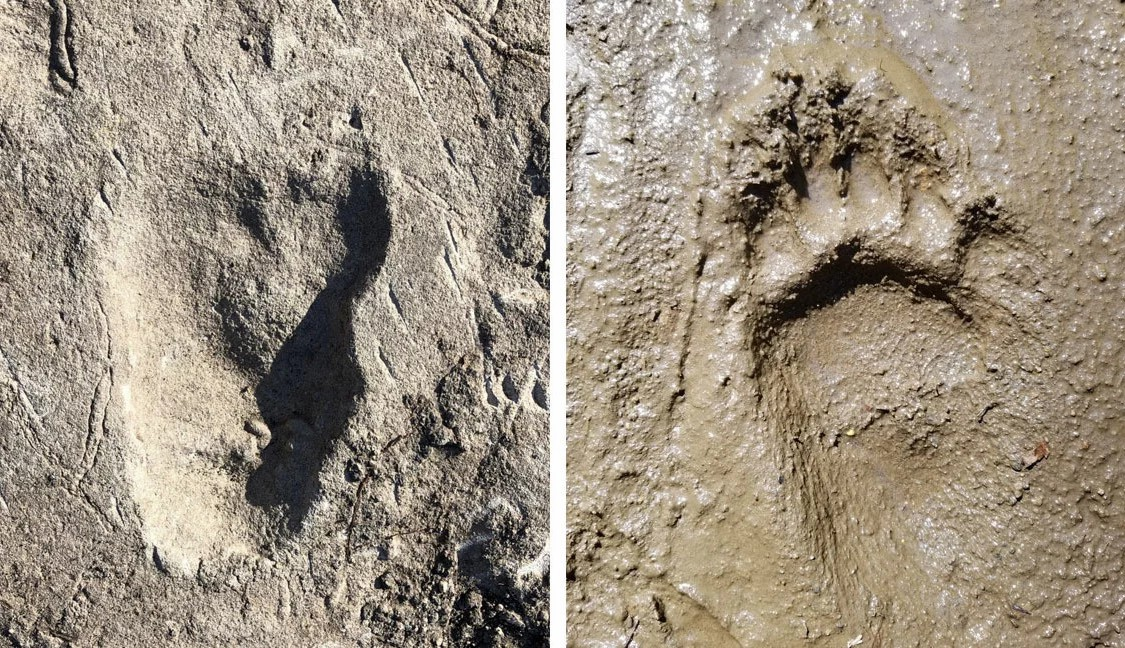
The early humans who walked the Earth nearly 3.7 million years ago were not walking alone. Fossil footprints in Tanzania reveal that two human species once lived in the same place at the same time.
Scientists had long thought that one set of unusual prints there was left by a bear walking on its hind legs, but a new analysis published in the journal Nature suggests that’s not right. Instead, it shows that the tracks were left by some unknown early human species that was wandering around that spot at the exact same time as Australopithecus afarensis(南方古猿阿法种) — the species of the famous partial skeleton(骨架) “Lucy”.
Australopithecus afarensis has long been assumed to have been the only human species living way back then, and scientists have considered it an ancestor of modern humans. But recent discoveries of other remains, such as jaws, skulls and foot bones, have implied that an unexpected diversity of hominins(古人类) may have lived during this period.
These ancient footsteps were trapped by a volcano. At this particular site, at Laetoli in northern Tanzania, all the footprints were made in the same layer of mud. That means individuals from these two early human species must have passed through within hours or days of one another, says Ellison McNutt, a biological anthropologist. It’s possible that the unknown species that made the unusual footprints “looked up across the landscape and saw an Australopithecus afarensis walking somewhere else,” she says. “It’s really cool that we may have two hominin species, at least, living at the same place.”
Walking on two legs is a unique and distinctive human characteristic. “It’s a very strange way of kind of moving through the world, and it’s very different from other animals,” McNutt notes, adding that how and why humans evolved to do this is still a mystery. “This seems to be one of the things that sort of makes hominins very different from the other living primates(灵长类).”
本时文内容由奇速英语国际教育研究院原创编写,未经书面授权,禁止复制和任何商业用途,版权所有,侵权必究!(作者投稿及时文阅读定制请联系微信:18980471698)
1.The rare footprints in Tanzania probably belong to __________ .
A an unknown walking bear
B Australopithecus afarensis
C an early human species
D the widely known “Lucy”
解析:选C。C 细节理解题。根据文章第二段可知,科学家长期以来一直认为那组不寻常的脚印是熊用后腿行走时留下的,但《自然》杂志的一项新分析表明脚印是一些未知的早期人类物种留下的,与属于南方古猿阿法种的著名“露西”几乎同一时期出现在该地点。即那组脚印是属于某种早期人类物种的,故选C。
2.What can be inferred from Paragraph 3?
A Australopithecus afarensis is an ancestor of modern humans.
B The unknown early human species lived about 3.7 million years ago.
C There might be more than two ancestors of modern humans.
D Australopithecus afarensis is the only early human species.
解析:选B。B 推理判断题。A项是第三段直接陈述的事实细节,无需推断;根据第三段最后一句的“an unexpected diversity of hominins(古人类) may have lived during this period”可知,科学家们认为该未知古人类物种与Australopithecus afarensis生活在同一时期,即第一段提到的“nearly 3.7 million years ago”,B项正确;第三段第二句But后的内容暗含该未知早期人类物种可能也是现代人类的祖先,加上Australopithecus afarensis,应该是两个祖先而不是超过两个,C项不正确;D项是科学家以前的观点。故选B。
3.What is the evidence of the two species living at the same place according to Ellison McNutt?
A The amount of mud layers found in the site.
B Their coming across in the site.
C Their passing through the road one after another.
D Their footprints’ appearing in the same layer of mud.
解析:选D。D 推理判断题。根据第四段可知,所有的脚印都是在同一层泥上留下的, 这意味着这两种早期人类物种的个体一定在数小时或数天内相继经过,即至少有两种古人类同时期生活在这一地方。故选D。
4.Why did humans develop into walking on two legs?
A To distinguish themselves from others.
B To move through the world.
C To become a mystery.
D It’s still an unsolved question.
解析:选D。D 细节理解题。根据第五段adding that how and why humans evolved to do this is still a mystery可知,人类为什么会进化成用双脚走路,这至今仍是不解之谜,故选D。